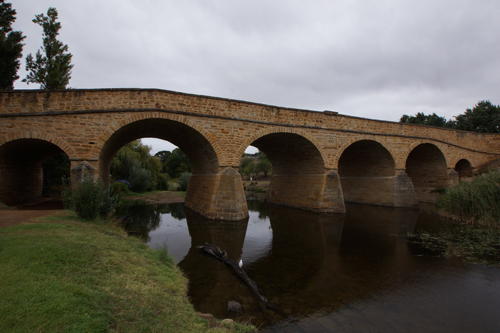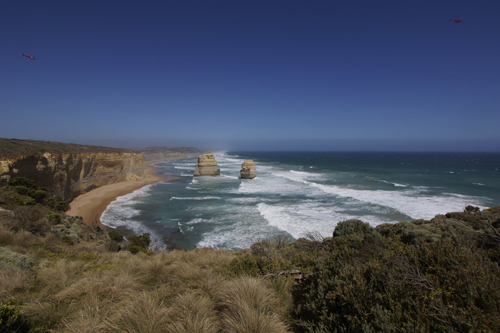We have recently spent 2 weeks travelling around Tasmania and then along the Great Ocean Road in Victoria. This was with our English friends, Pat and Graham, from Dorset.
Being a tourist in your own country is an eye opener, as you start to see you home from a different perspective.
Not as a local but as a visitor.
We met Pat and Graham in Launceston and had intended to travel west towards Strahan, via Cradle Mountain. We had never seen that side of the island and we knew that they wanted to see some of Tasmania’s wilderness areas.
This was not to be.
In the week leading up to our visit bushfires had developed right across the north and west coast areas. Spring 2015 was the driest on record and the conditions were described by farmers as the worst in 70 years.
So after a night in Launceston we headed east, away from the fires, through St Helens and down the coast to Bicheno.
It was in Bicheno that the Tasmanian drought broke.
The temperature plummeted and the rains were torrential. So much so that our apartment in ‘Bicheno By The Bay’ flooded.
Pat and Graham had come to Australia for warmer, dryer weather. After all this was the land or oranges and sunshine.
On that particular day the temperature was higher in London than on the east coast of Tasmania.
In Bicheno we were told that there was a colony of Fairy Penguins (for politically correct reasons they are now called Little Penguins) just near the hotel, so we went out in search of them. It was raining and we were out in the dark, getting wet and cold. Pat and I decided to return to the apartment but Graham was undeterred so he and Thea stayed out in the foul conditions a little longer.
The penguin sightings were few and far between.
The next day we headed further south and spent hours walking around the Freycinet Peninsula. This stunning 18km hike took us to Coles Bay and then over the peninsula to Wineglass Bay.
Despite the rain Pat and Graham always carried their bathers. This was Australia and they were determined to swim whenever there was an opportunity.
We didn’t worry, they’re English.
Port Arthur was our next destination.
I have been to Port Arthur three times and on each visit the somberness of the place is reflected by the gloominess of the weather.
This time was no different.
What was different however is the development of this historic site. This is now a truly world class tourist attraction that showcases the brutality of the convict settlement – this was slavery in the guise of a penal colony.
Hobart Town was thriving, Van Dieman’s Land needed workers and prisoners were a cheap, available labor force.
The rain alternated between drizzle and downpour but we continued on our discovery tour. Pat and Graham seemed unfazed by the rain and by the end of the day we were all soaked to the skin.
They didn’t worry, they’re English.
Hobart was next, and as our hotel was very close to Salamanca Place, visiting the Saturday market was placed on the agenda.
This is a huge market that almost takes up the entire length of Salamanca Place. It’s sells everything from local arts and crafts to plush toys like Tasmanian Tigers and Tasmanian Devils.
Surprisingly most of these were made in Tasmania and not China.
That afternoon we visited the Cascades Female Factory. Again we found the whole tourist experience professional, enlightening and very confronting.
In many cases the women were treated more harshly than the men, and again were nothing but slave labor for the fledgling settlement. And even worse, any child that was born to a convict in the Female Factory had little chance of survival, as the mortality rate was almost 100%.
If by some chance a child did survive they would have been mute, as there was a strict code of silence in the gaol – so language skills were never learnt.
The Cascades Female Factory and Port Arthur, along with nine other convict sites form the Australian Convict Sites World Heritage Property. These sites highlight the growth, through forced migration, of the Australian nation.
There was an exhibition of photography at both Port Arthur and the Cascades Female Factory by Mine Konakci, titled ‘A convict in the family?’ This was inspired by the fact that from 1787 to 1868 over 160,000 convicts were transported the colony, and many Australians have identified a convict in their family history. Mine posed the descendant with props, directly relating to the crime that had been committed.
This was a very creative way of connecting the past with the present.
Later that day we drove north east to Richmond. This is a well preserved tourist town, best known for its bridge that was completed in 1825 and is the oldest in Australia.
On our last day in Hobart we took the catamaran up the river to MONA (Museum of Old and New Art). The current exhibition was a Gilbert and George Retrospective – 97 pictures painted from 1970 to 2014. To my mind Gilbert and George are a well oiled ‘art factory’. Via a controlled form of graphic design, they use their distinctive style to make social commentary.
It’s not to everyone’s taste but you wouldn’t expect anything that David Walsh does at MONA to be main-stream.
Having had enough of art, culture and history we left Hobart and headed north to Pine Lake on the Central Plateau. This is part of the Tasmanian Wilderness World Heritage Area. It was here that the sun finally broke through and we got to see some blue sky.
On the road to do the Liffey Falls walk we met a group of ‘Firies’(male and female firefighters) heading back from a week in the state’s north west.
It was great to chat to them and get a small insight into their battle with the Tasmanian bushfires.
That night, at our motel in Deloraine, there was another group of sixteen firefighters, this group from New South Wales and the Australian Capital Territory.
It was an interesting encounter for Pat and Graham, after all there aren’t that many bushfires in Dorset.
On our final day in Tasmania we drove from Deloraine to Springlawn Lagoon in the Narawntapu National Park.
Just off the track in the National Park is Bakers Beach, a long stretch of sand and surf that opens out into Bass Straight.
The beach was deserted and the water cold, but it was here that Pat and Graham finally got their only dip in Tasmanian waters.
They didn’t mind, they’re English.
We flew back to Melbourne for a week of sightseeing on home soil.
Graham discovered Sandringham Beach, which is less than 200m from our front door, and a dip before breakfast briefly became part of his daily routine.
After two days exploring Melbourne we made the trip down the Great Ocean Road to Lorne and then Port Fairy. On the way down to Lorne Pat and Graham had a swim at Urquharts Bluff. There was a surf class finishing up on the beach as we arrived. The young girls looked frozen, even though they all were well insulated with their winter wet suits or ‘Steamers’.
As Pat and Graham plunged into the surf, with nothing but their togs on, I got a strange, questioning, look from one of the instructors.
“Don’t worry”, I said, “they’re English.”
Lorne was a bit of a nostalgic journey for me, having spent two summers working there while I was at college. We had a drink in the Pacific Hotel, where I worked and breakfast at the Arab, which was the ‘cool place to be’ back in the 60s.
Graham again found the beach and while we had breakfast he went swimming.
One of the main reasons for the drive along the Great Ocean Road was to visit the Twelve Apostles.
We weren’t the only tourists with that idea.
Every vantage point was crawling with them. They came by the coach load and by private vehicles. We later discovered that the reason for the swell in numbers was Chinese New Year. The coaches were full of Chinese tourists while the private cars were local Chinese getting out of town for a couple of days.
They were all there to celebrate The Year of the Monkey.
On the way to the Twelve Apostles we passed through Separation Creek and Wye River. Evidence of the devastating Christmas Day Bushfires lay as a black carpet along the roadside.
However the rejuvenation had already started and the were patches of green sprouting from the charcoaled tree ferns.
We spent that night in Port Fairy, a delightful seaside resort town with an abundance of good pubs, restaurants and accommodation.
Taking the inland route back to Melbourne we briefly stopped off at Ballarat and gave our visitors a quick glimpse of this product of the gold rush.
Much to our visitors delight we got to see, and photograph, a couple of rather sleepy koalas. They were high up in a gum tree on the Hopkins Highway, south of Mortlake.
Once we were back in Sandringham we did the usual walk to Half Moon Bay, again Pat and Graham has a splash. While the next day we drove around the Mornington Peninsula, visiting the Merricks General store for a coffee and Arthurs Seat for a view. Then it was down to the bay and into Sorrento. There we did the ‘Millionaires Walk’ past the homes of the rich and famous.
Needless to say Pat and Graham’s togs got wet again, this time at both the front and back beaches of Sorrento.
While Pat and Graham swam at every opportunity, our bathers never got an airing – it was far too cold for us.
Don’t worry, we’re Australian.











